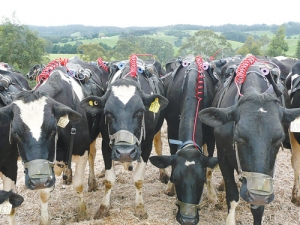Several projects measuring methane emissions from dairy cows have calculated increased weight and milk production responses.
The methane creates a loss of energy, so reducing emissions enables the energy to be metabolised elsewhere, according to the scientists.
"Methane is energy and a greenhouse gas, 25 times more powerful than carbon dioxide," said Dr Peter Moate, senior research scientist at Ellinbank.
"So a dairy cow is equivalent to a family motor car in its greenhouse emissions and effect.
"Our research has been like an insurance policy, so that if in future Australian dairyfarmers are asked to reduce methane emissions from cows, they will have real options to do that.
"And our research is uncovering a lot of practical feeding strategies, suitable for the Australian dairy industry, for reducing methane emissions.
"If you save energy otherwise lost in methane emissions, you should, theoretically, be able to convert that into increased production – either body weight or milk."
Experiments at Ellinbank on 70% forage-fed cows showed methane emissions were 21.1g/kgDM intake.
"I've measured the methane intensity of Australian milk by measuring the cows' burps and calculating that against milk production," Moate said. "In 1980, it was 33.6g methane/ kg milk produced. Thirty years later, as the milk production of the cows has increased, it decreased to 19.9g methane/kg milk."
Moate said better genetics, feeding and pastures caused the reduced measures. "So farmers are to be congratulated for their efforts, being efficient and using the benefits of scientific research.
"What can Australian farmers do to further reduce methane emissions? Well, obviously feed additive, 3-nitrooxypropanol (NOP) is one option when it becomes available.
"Several others we've researched include fatty feed supplements – cotton seed meal, cold pressed canola, brewers grains, homily meal, grape marc. These contain a high amount of fat; feeding those to cows you are able to decrease methane emissions by 10-25%. But it has to be economical; we're not advocating farmers use these unless it's economical for them."
Moate said summer, when pastures were dry, with reduced protein and fat, was an ideal time to provide these supplements.
Feeding high amounts of wheat to dairy cows can substantially reduce methane emissions. In one experiment, feeding 10kg of wheat/cow/day reduced methane emissions by 50%.
In another experiment, cows fed on a basal diet of pasture and 9kg wheat had methane emissions lower by 35%.
"Wheat feeding is a standard on many Australian dairy farms and it's likely the amount of methane being produced by those cows is less than we previously thought," Moate said.
Further research about wheat's anti-methane effect is being done.
The sulphur-hexafluoride (SF6) technique developed by Ellinbank scientists, to measure methane/kg/DM eaten by pasture-fed cows, has been adopted in other research. A brass capsule is swallowed by the cow, where it lodges in the rumen. The SF6 is diffused as a gas through a teflon membrane on the capsule's end, at a constant rate of 5mg/day, mixed with the methane in the cows' rumen and expelled as burps.
Burps were measured using a tube suspended over the animal's nose which sucked the air through and into a saddle apparatus around its body.
"It turns out the cows produce about 21g methane/kgDM eaten; it applies to all diets of more than 70% forage," Moate said.
An international team of scientists from Ellinbank and Penn State University, USA, discovered a feed additive included in the diet of 48 barn-stalled dairy cows reduced their methane emissions by 30%.
One gram of the feed additive, 3-nitrooxypropanol (NOP), was added to the daily grain feed ration for each cow for 12 weeks. Methane emissions were measured using the SF6 technique.
"Adding NOP into the daily feed reduced the cows' emissions of methane gas by 30%," said Moate.
"About 6% of the food the cow eats is converted to methane gas, which is wasted food and energy. Considering cows burp about 600 litres of methane daily, if you save the energy it has to go somewhere – we expected it to go into milk or milk fat.
"The cows given NOP captured the energy and converted it into increased body weight by 1kg/week, indicating more energy was available for the cow when methane production is reduced. Importantly, there was no reduction in milk production or composition."
Moate has applied for approval to conduct the NOP research on Australian dairy cows grazing pasture, to determine whether the methane inhibiting effect was similar.
"No other feed additive has had such a big effect on methane, using such a small amount. So there is a possibility to add that to feed of cows," he said.
Heat tolerance and yield
Temperature and humidity controlled chambers (calorimeters --pictured) are being used to replicate the effects on cows of a mild to moderate heat wave.
Farm records were used to identify cows that maintained milk yield figures on hot days and 48 related heifers were bought for the research project.
Six cows spend four days in the calorimeter, where oxygen intake, methane and carbon dioxide emissions and heat production are measured.
The cows are fed crushed corn, crushed wheat, crushed barley and rolled barley, to identify any differences in methane emissions.
Blood tests taken one week prior to entering the chamber and at day three in the chamber identified genetic changes in milk production, insulin, glucose and non-steroidal fatty acids.
Milk samples were also taken to measure feed conversion and gauge milk secretion ability of mammary glands during heat stress.
The blood tests were also expounding genetic markers for feeding efficiency, heat tolerance and milk production phenotype work that can develop breeding values and feed conversion figures for the Breeding Value Index.
This work is led by a geneticist, associate professor Ben Hayes (AgriBio Centre, Latrobe University) with Ellinbank scientists Dr Joe Jacob and Josie Thornhill.
Thornhill said preliminary observations indicated obvious visual adaptive responses. "Heifers identified as more heat tolerant are mimicking their maternal forebears, keeping their core temperatures more stable," Thornhill said.
She said preliminary data indicated the maternal milk production figures would also be replicated.
Jacobs said identifying genetic markers for different production aspects could help identify cows that maintained milk production or body weight during hot weather.
"This research should be able to standardise a temperature and humidity index, to be applied to other animals," he said.
While initially the genetic markers research is being related to bulls' estimated breeding values (EBVs), ultimately it would be extrapolated to maternal EBVs, according to Jacob.


















